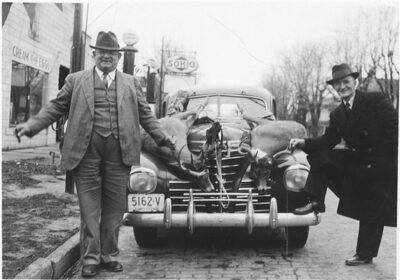
Image source: robertreynolds.weebly.com
I have an image in an old Outdoor Life magazine that stirs my soul every time I gaze at it. In this particular picture a hunter is walking through a stretch of Eastern woods with a wool cap on his head, a thick checkered flannel shirt, and knee-high laced boots. The look on his face is the look of a man determined to fill the freezer and provide for his family. It is the look of a hunter.
The image comes from the mid 1950s, and the man could be anyone’s grandfather. He carries little equipment on his person, much less than the 500 pounds of gear we hunt with today. He has a leather belt with a sheath knife, a few spare cartridges, what looks to be an army surplus canteen, and precious little else. What really captures my attention in the photo, aside from the set look on this hunter’s face, is the worn and battered Winchester Model 94 he carries in his gloved hands.
By today’s standards, a ’94 Winchester and its competitor, the Marlin 336, are archaic throwbacks to the dawn of the 20th century. In truth, they are stubborn holdovers from a time when lever-action rifles and new smokeless powder cartridges were joined in marriage. This happened in the 1890s around the same time Teddy Roosevelt led the Rough Riders. Most of these rifles were, and are, chambered in .30-30. The “Thuddy-Thuddy” was the first modern small bore, big-game cartridge designed in the USA for a hunting rifle. Don’t let the age of the caliber scare you; it is still quite effective in the fields and in the brush.
Ultra-Efficient Water Filter Fits In Your Pocket!
The .30-30 is not going to win any long-distance shooting competition. For the sake of safety (pointed rounds loaded end to end in a tubular magazine is a bad idea), most manufacturers of this caliber use rounded nose bullets in the cartridges. Just as soccer balls cannot be thrown as great a distance as a football, so it is with the .30-30. The maximum range you would ever want to take game with the .30-30 is only 250 yards. Believe me: You’ll be shaking like a leaf at that distance.
While the short range, .30-30 is not going to bring you trophies at the Camp Perry long-range competition, but it can and will put meat on the table. As the round is a .30 caliber projectile, it offers plenty of knock-down power to the hunter for medium-sized game. I would bet my year’s wage (and come away richer!) that one-third of all deer taken on this continent over the past 100 years have fallen to the .30-30. The round is a perfect brush gun, as the weight of the bullet will not let small branches or twigs argue with its course as it proceeds with gusto to its quarry. When the round comes in contact with the game animal, its 1,600+ foot pounds of pressure will stop a large buck in its tracks.

Image source: wideopenspaces.com
In truth, probably as many elk and moose have fallen in the West and North to this cartridge as compared to any other common modern sporting caliber. There are stories that have come out of Alaska and the Pacific Northwest of trappers and hunters who, with white knuckles and wet britches, defended themselves from brown bear with a .30-30.
Shooting a .30-30 is pleasant and the cost to the shoulder is only 10-11 pounds of felt recoil, which is half of what the venerable .30-06 offers. Women and children especially can appreciate the soft recoil, and less bruising a rifle chambered in .30-30 will offer. Accuracy with a Marlin 336 or Winchester ‘94 is quite decent, even with open sights. The accuracy, of course, improves with the addition of a 3-4 power scope if so desired.
The Secret To Starting Fires In Even The Most Extreme Conditions
The workmanship of the Winchester ‘94 rifles has almost always been of the highest quality. A strong advantage to the Winnie is in the smoothness of the action. In this it beats the Marlin hands down. A disadvantage of the ’94 is the top ejection receiver, which negates the possibility of a top-mounted sight, and requires any optic to be mounted on the side.
The Model 336 is my personal favorite of the two. However, be wary of buying one built between 2008 and 2013 In 2008 the Marlin Firearm Company sold out to Remington, and quality went downhill fast. To be honest, it was as if Remington assembled them at 2 in the morning. In the dark. With a sledgehammer. While they were intoxicated.
A pre-2008 Marlin, or a new construction “Remlin” as they are not so affectionately called today, is a well-built rifle indeed. The micro groove barrel will easily last a lifetime of shooting, and the action is much sturdier than the Winchester, albeit not as smooth. The receiver is tapped and drilled and can accept scope mounts and optics.
Ammunition is plentiful, and varied. In fact, there never seems to be a shortage of .30-30. In the great ammo shortage following the 2013 gun ban scare, I was still able to buy .30-30 ammunition, although I had trouble finding food for my AK.
These rifles are far from obsolete, though perhaps eclipsed by more modern rifles and cartridges. But for the meat hunter, the freezer filler, and the farmer, the .30-30 is the “good enough gun,” which performs every time.
What do you think of the .30-30? Share your thoughts in the section below:
Learn How To ‘Live Off The Land’ With Your Gun. Read More Here.
 Off The Grid News Better Ideas For Off The Grid Living
Off The Grid News Better Ideas For Off The Grid Living



